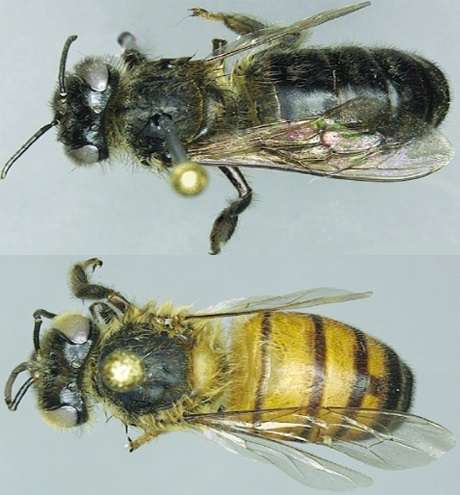East African honey bees are shown. The dark monticola bee (top) is associated with the isolated highland forests and the bright scutellata bee (bottom) occurs in the surrounding lowland savannahs. Credit: Andreas Wallberg and colleagues.
Mountain-dwelling East African honey bees have distinct genetic variations compared to their savannah relatives that likely help them to survive at high altitudes, report Martin Hasselmann of the University of Hohenheim, Germany, Matthew Webster of Uppsala University, Sweden, and colleagues May 25th, 2017, in PLOS Genetics.
Honey bees living in the mountain forests of East Africa look and behave differently from bees inhabiting the surrounding lowland savannahs. Mountain bees are larger, darker and less aggressive than savannah bees, and can fly at lower temperatures and conserve honey when flowers aren't blooming. To understand the genetic basis for these high-altitude adaptations, researchers sequenced the genomes of 39 bees from two highland and two lowland populations in Kenya. The genomes of all the populations are highly similar, but two regions located on chromosome 7 and 9 show consistent differences between bees living in high and low-altitude environments. The segment on chromosome 7 contains e.g. receptor genes for a neurotransmitter called octopamine, which plays a role in learning and foraging. The clear divergence of these two genetic variations suggests that they have an ancient origin and likely existed in bee populations before the groups spread their mountain and savannah habitats.
This comprehensive study of the genomes of high-altitude honey bees in Kenya reveals novel insights into their evolutionary history and the genetic basis of local adaptation. Scientists had thought that mountain and savannah populations were each distinct sub-species. The high degree of similarity in their genomes, as revealed in the current study, shows that they constantly interbreed. The highly diverged segments likely represent structural rearrangements, such as inversions, in which the exchange of genetic material is suppressed. Previous studies have identified octopamine as an important signaling molecule in other insects living in low temperature and low oxygen conditions.
Martin Hasselmann adds: "Our findings complement several other landmark studies (for example in Heliconius butterflies and Solenopsis ants) where adaptations have been similarly tied to structural variants or supergenes. However, this phenomenon has never been documented in honey bees before. Our results should therefore spur further research into the role of supergenes in environmental adaptation. We are planning now to measure the distribution of these divergent segments in other geographic locations and to elucidate the functional link of these genes with behavior."
More information: Wallberg A, Schöning C, Webster MT, Hasselmann M (2017) Two extended haplotype blocks are associated with adaptation to high altitude habitats in East African honey bees. PLoS Genet 13(5): e1006792. doi.org/10.1371/journal.pgen.1006792
Journal information: PLoS Genetics
Provided by Public Library of Science























